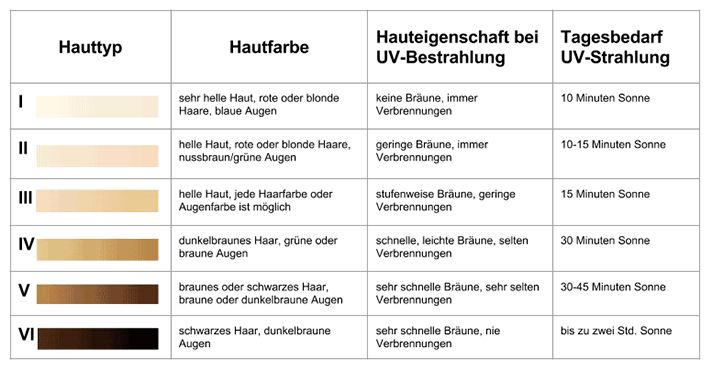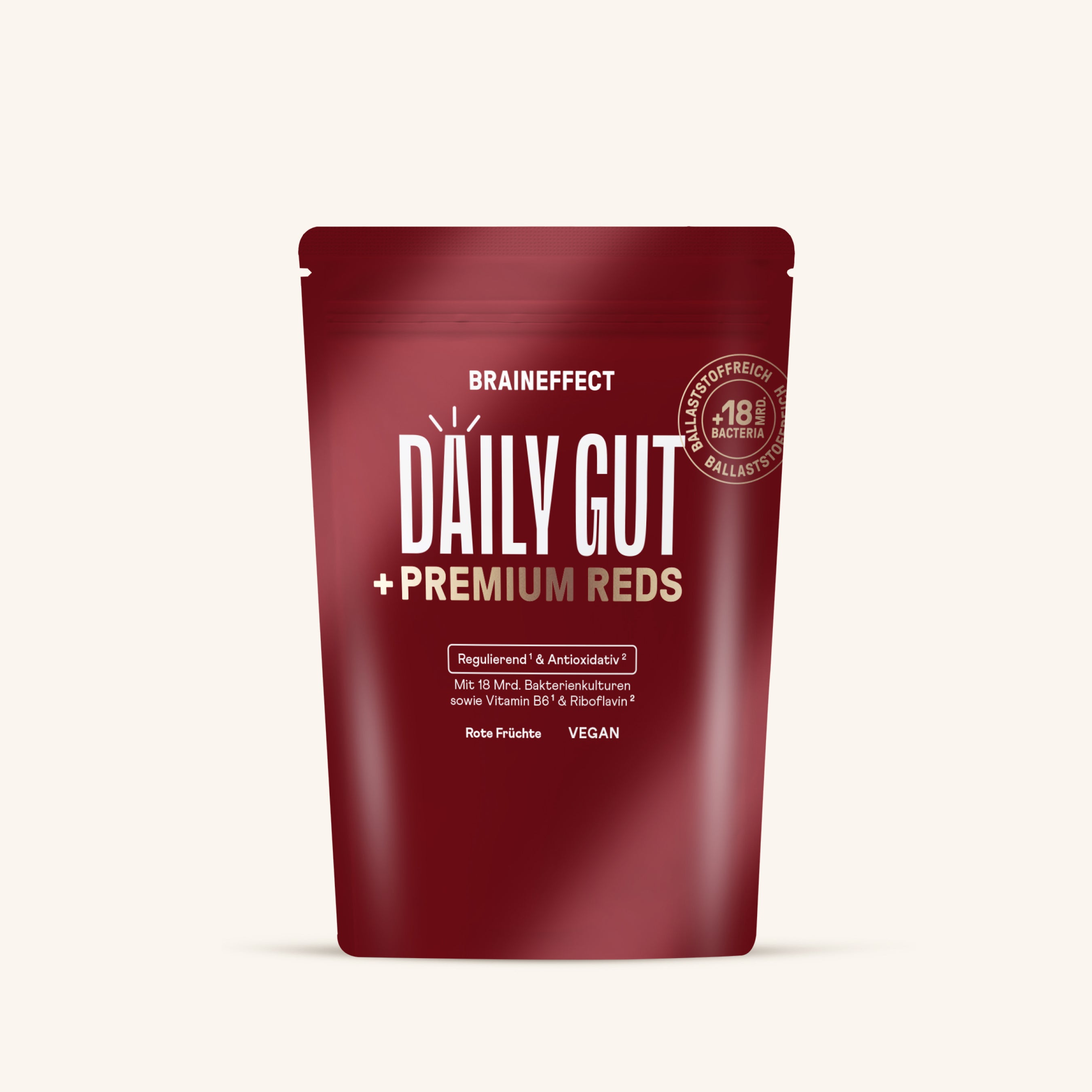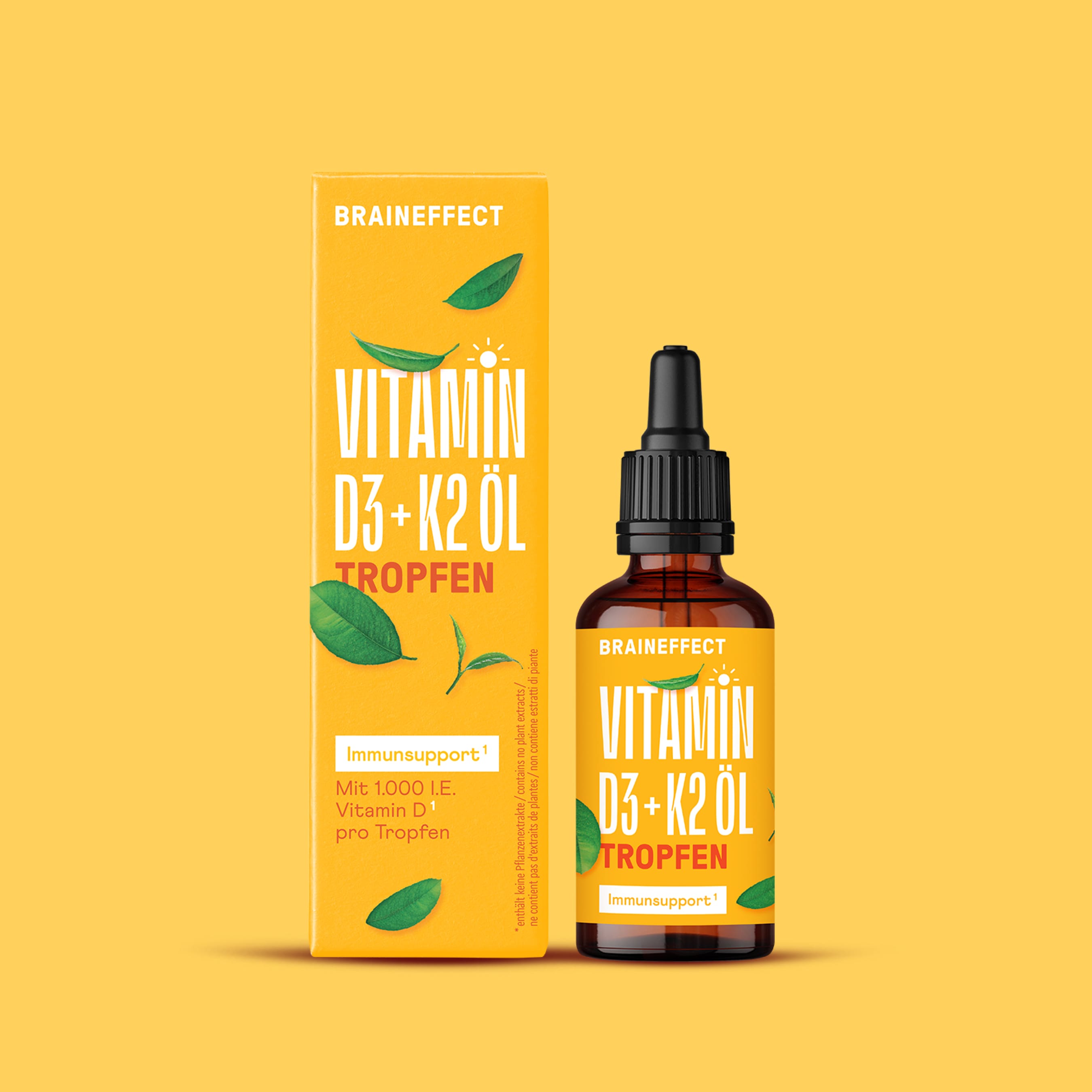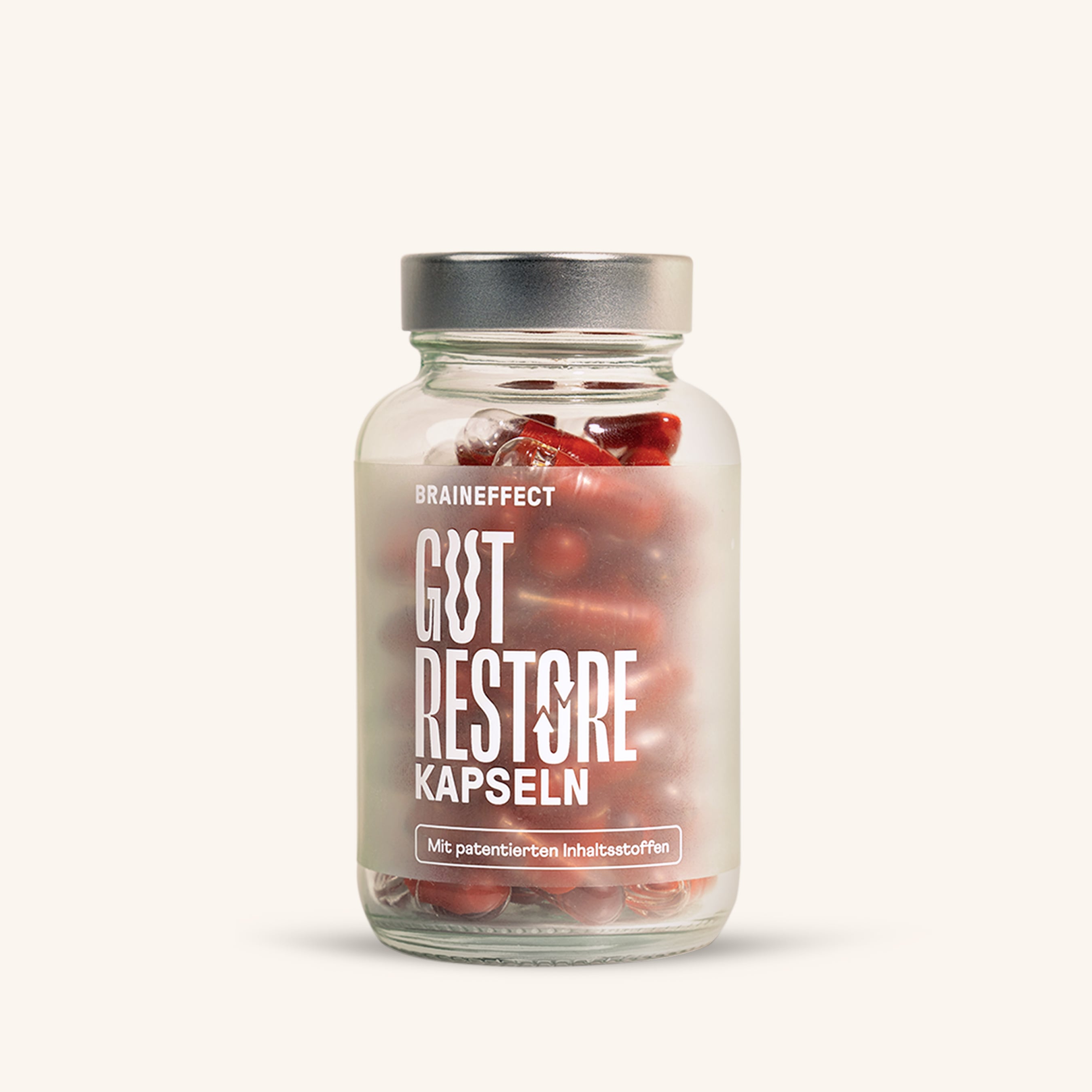Vitamin D is one of the most important vitamins. It's also called the sunshine vitamin because it's not only found in food but can also be produced through your skin with sufficient sun exposure.
However, in winter, with high levels of stress and an unbalanced diet, vitamin D deficiency can occur. [1] We'll tell you how to recognize a vitamin D deficiency and how to correct it.
Doctors and researchers agree: Vitamin D supports your immune system and is an important component of many other processes in your body .
Discover our high-quality vitamin D
Table of contents
- What is vitamin D?
- How does vitamin D work in your body?
- Vitamin D requirements: How much vitamin D do you need?
- Vitamin D deficiency
- Vitamin D deficiency and its causes
- Vitamin D deficiency - the symptoms
- Vitamin D deficiency - a test brings clarity
- Correct vitamin D deficiency
- Vitamin D in combination with vitamin K2
- Your vitamin D product
- Conclusion
- Sources
1. What is vitamin D?
Numerous myths surround the so-called sunshine vitamin, and there are countless good tips for improving your vitamin D levels. In addition to a vitamin D-rich diet, you can also produce vitamin D yourself .
All you need is UV-B radiation . This allows the body to produce vitamin D3 naturally. A daily sunbath of 15-20 minutes is essential, with your face, arms, and legs uncovered.
Especially for women who rely on day creams with sun protection factors, it's often not easy to produce vitamin D through the skin. The sun protection factor inhibits its production . Taking a short walk in the sun before applying sunscreen in the morning isn't just good for your well-being.
Take Home Message #1: Vitamin D is also called the sunshine vitamin because it can be produced not only through a balanced diet but also through the sun's UV-B radiation.
2. How does vitamin D work in your body?
But why is this vitamin so important and essential for you? To understand this, you first need to understand how it works. Strictly speaking, vitamin D doesn't even belong to the group of vitamins. These are substances that the body cannot produce itself. Vitamin D, however, is already present in the body, in a sense, as the inactive precursor 7-dehydrocholesterol .
UV radiation activates the active substance, including cholecalciferol. However, it first undergoes a conversion step and becomes the hormone "calcitriol." This hormone affects , among other things, the body's calcium supply . This, in turn, affects your bones . Calcitriol also modulates the immune system .
On a mental level, adequate intake is also important. It influences the normal function of our hardware , ensuring not only a quick mind but also normal muscle function . Vitamin D is therefore particularly important for embryos and infants.
Biochemically, it plays a role in brain development. Pregnant women therefore have an increased need for it and should be careful not to suffer from a deficiency. Vitamin D also has another important function in the body.
It regulates the brain messenger serotonin , also known as the feel-good hormone , and thus indirectly affects your mood. If there's just too much of this vitamin in the blood, it is converted into its storage form, 25(OH)vitamin D3, and stored.
Vitamin D is essential for …
- your bones
- to support your immune system
- cell division
- the production of serotonin
BRAINEFFECT HACK : The sunshine vitamin, vitamin D, supports the normal function of your immune system, even in winter. To provide you with a quick and easy supply of vitamin D, we've developed our high-dose VITAMIN D3+OIL . Just one drop a day is enough to replenish your vitamin D levels.
Discover our high-quality vitamin D now
3. Vitamin D requirements: How much vitamin D do you need?
The amount of vitamin D needed depends fundamentally on each individual. Each individual produces vitamin D at different rates and in different amounts. For example, the body's own production is significantly slower in older people . Pregnant women also have an increased need , as the embryo also needs to be supplied.
Your skin color also has a significant influence on the production of vitamin D. The lighter your skin , the faster vitamin D can be produced. This poses a particular problem for people with dark skin who live in northern latitudes with low sunlight.
Assuming a skin type II to III (light to medium skin tone), the constant minimum value is 75 nmol/l , with an ideal level of 100 nmol/l or higher. For comparison, in the midday summer sun, 10 to 20 nmol/l of vitamin D is produced and released into the blood over the next 24 hours.
As a general rule of thumb for sunbathing: If your skin starts to turn red, you should get out of the sun or apply sunscreen. After that, your body produces very little vitamin D. If you want to know your vitamin D needs , you can take a blood test . You can either go to your doctor or do it from the comfort of your own home .
Thanks to new startups and tests, this is child's play. The first step is to take a drop of blood from your fingertip , then send it to the Cerascreen laboratory , and view your results online after a few days. We work with our partner Cerascreen on this.
Take Home Message #2: The amount of vitamin D each person needs varies greatly from person to person and depends on various factors such as skin color, age, and weight. It's best to take a vitamin D test to check your vitamin D levels.

4. Vitamin D deficiency
A large-scale study by the Robert Koch Institute shows that approximately 50% of Germans are not optimally supplied with vitamin D. [2] The supply depends heavily on various factors. These include: nutritional status, age, work environment (indoors/outdoors), skin tone and pigmentation, calcium intake, and, of course, sun exposure.
The latter, in particular, is essential for vitamin D production in your body, as you learned earlier in the article. Combined with a generally low dietary vitamin D intake, this leads to an increased risk of vitamin D deficiency. [3]
A vitamin D deficiency can have consequences for your health. A vitamin D deficiency causes certain processes related to the immune system, muscles , and cell division to no longer function optimally . This can impair your overall performance .
5. Vitamin D deficiency and its causes
But why do so many Germans suffer from a deficiency of this important substance, sometimes even in the summer? A study from the University of Wisconsin examined the possible causes of vitamin D deficiency in the summer. [4] They discovered that many people are deficient, even though they spend a lot of time in the sun. There are several possible causes:
1. The latitude
Latitude determines the intensity of solar radiation . Regions north of Barcelona (42nd parallel) and south of Berlin (52nd parallel) receive sufficient sunshine during the summer months. All regions north of Berlin do not receive sufficient sunshine even in the summer. Thus, most of Germany receives sufficient sunshine, at least during the summer months.
2. Unbalanced diet
Vitamin D is also found in many foods. Cod liver oil, eel, herring, salmon, oysters, tuna, various mushrooms, avocados, eggs, and cheese contain significant amounts of vitamin D. However, if you don't make sure to regularly consume some of these foods, you can quickly develop a vitamin D deficiency.
3. Office work & long clothing
Whether the sun shines in summer or not, many people do not have the opportunity to take advantage of the sunshine and spend 8-10 hours a day indoors .
Do you also work in an office? Then you're like most people. Few people do a daily activity that takes them outside and into the sun.
If you sit in an office all day, it doesn't matter what time of year it is. Even if you take advantage of the last hours of sunshine after a long day at work, it won't do much good if you're on a vitamin D-deficient diet. In the evening, the sun is already lower in the sky and the UV radiation is less intense . This results in another vitamin D3 killer.
People who just left the office rarely wear shorts and tops. It's important that a large portion of the skin is exposed to the sun to produce sufficient vitamin D3. Just the face and arms aren't enough .
Therefore, if you deliberately expose yourself to the sun for a period of time, large areas of your skin should be exposed and not covered by long clothing. You should also be careful not to use any sunscreens with UV protection beforehand, as these inhibit the production of vitamin D.
4. Age
Another surprising reason for the high prevalence of vitamin D deficiency in Germany is that the body can produce less vitamin D with age . Older people are therefore potentially more at risk of vitamin D deficiency than others. Why is this? This connection with age has already been demonstrated in several studies. There are several reasons for this, which ultimately lead to a more severe vitamin D deficiency than in younger people.
Older people are increasingly less active and spend less time outdoors . As a result, they are exposed to the sun much less frequently, which is essential for vitamin D production. In addition, appetite decreases with age, and thus the already low dietary intake of vitamin D decreases.
A third point is that nutrient absorption decreases with age. Finally, the skin of older people becomes increasingly thinner, which also impairs vitamin D production. All of this leads to a change in vitamin D metabolism and thus a significantly increased risk of vitamin D deficiency. 5
5. Skin color
How much vitamin D you need, or how quickly it's produced in your skin, depends on your skin color. Your latitude, combined with your skin color, plays a key role in determining whether you're adequately supplied. Why? The darker your skin color, the slower vitamin D3 is synthesized by UV radiation.
This is actually a useful bodily function, but in one case it can become problematic. People with darker skin who live in northern latitudes often suffer from a deficiency if they have an unbalanced diet, as they produce vitamin D3 very slowly and there is less UV radiation.
6. Sunscreens & sunblockers
Sunscreens are a sensitive topic. On the one hand, they are extremely important, as the risk of skin cancer should not be underestimated. On the other hand, the sunscreen's sun protection factor ensures that the sun's UV radiation does not reach the skin as effectively. This is precisely what is necessary for vitamin D3 production.
Many people are afraid to go out into the sun without SPF because they're so afraid of UV rays. This puts their bodies into a state that's equivalent to a permanent winter. No UV radiation means no vitamin D3 production through the skin. However, to avoid risking long-term skin damage, you shouldn't skip sunscreen. Some UV radiation always reaches your skin.
7. Showering after sunbathing
Especially in summer, the numerous hours of sunshine can be optimally utilized to boost your vitamin D levels. Whether you're taking a walk, visiting the outdoor pool, or sunbathing on a lounge chair, you'll feel truly kissed by the sun and then treat yourself to a relaxing shower. Sure, the sun makes you sweat, and many people feel the need to rinse their skin afterward. That's a fatal mistake!
As we've already learned, vitamin D is produced, among other things, in the skin. Strictly speaking, it can take up to 48 hours for all the vitamin D produced by the sun to pass from the skin into your blood. Showering immediately after sunbathing will wash it all away.
A study from the University of North Texas investigated precisely this phenomenon . 6 The researchers discovered that vitamin D, or rather its precursor vitamin D3 (cholecalciferol), is primarily produced in sebum , i.e., directly on the skin rather than in it . The valuable substance thus sits, in a sense, on your skin. This is problematic because when you wash your skin with shower gel, it removes the oily components from your skin .
So what does this mean for you? To retain valuable vitamin D, it's best not to shower for 4-6 hours after sun exposure. This can sometimes be problematic or even impossible. Therefore, you should at least try to avoid shower gel or apply it to large areas of skin.
Take Home Message #3: As you've now learned, sunshine, along with a balanced diet, is essential for vitamin D production in your body. Your health is important, so you should pay attention to your vitamin D levels! How can you maintain it? Get out into the fresh air and into the sunshine! But, of course, you shouldn't overdo it. Because, as with many things, too much of a good thing isn't always optimal.

6. Vitamin D deficiency - the symptoms
There are a few signs you can look out for to determine if you have a vitamin D deficiency. The tricky part, however, is that the signs of a mild vitamin D deficiency are very nonspecific and can have other causes .
According to studies , the following factors can be early signs of a vitamin D deficiency:
- low well-being
- Winter blues
- weakened immune system
- you can no longer achieve your normal performance during training
Replenish your vitamin D stores now
7. Vitamin D deficiency - a test brings clarity
To determine whether you have a vitamin D deficiency, it's not enough to simply look for the symptoms described. Only a blood test can confirm whether you have a vitamin D deficiency or not.
A vitamin D test can be performed by your family doctor , but there are now also self-tests , such as those from Cerascreen , that can be performed at home .
A few drops of blood are drawn from a finger using a lancet and sent to a specialized laboratory on test strips. This laboratory then checks the amount of 25-OH vitamin D (calcidiol) present in our blood—this is the form of vitamin D found in our blood. The results can be easily viewed online.
Take Home Message #4: There are symptoms that indicate a vitamin D deficiency, but only a blood test can provide absolute certainty. This can be performed either through a self-test or by a doctor.
Discover the vitamin D test now
8. Correct vitamin D deficiency
If your blood test has shown that you have a vitamin D deficiency, then you should now start by first correcting the deficiency and secondly maintaining your vitamin D levels. Naturally obtaining vitamin D is, of course, a good option, but it's now clear that this isn't always possible or easy.
Changing your diet can be challenging. There are some foods that contain high levels of vitamin D, such as eel and animal liver.
If you don't want to eat eel and liver every week, here's a suggestion for you: You can buy vitamin D supplements like BRAINEFFECT VITAMIN D3 + OIL , which contains the important vitamin in the right dosage.
The German medical journal recommends supplementing with 1,000 IU of vitamin D per day , which corresponds to one drop of BRAINEFFECT Vitamin D3+OIL .
This increases the blood concentration by approximately 25 nmol/l daily. The German Society for Nutrition (DGE) currently recommends a dosage of 800 IU per day for adults. The amount varies in other countries , where higher doses are indeed recommended .
The individual dose can best be determined with a blood test, thus optimizing the body's vitamin D levels. Accordingly, higher amounts than the 800 IU recommended by the German Society of Nutrition (DGE) should definitely be discussed with your doctor after the blood test. 7
In other countries, the use of supplements is already much more advanced. There, foods such as milk, dairy products, and cereal are increasingly being enriched with vitamin D. This can be a good option. Another possibility would be to increase the use of foods that naturally contain vitamin D.
Light therapies can also be used to correct a vitamin D deficiency. These include daylight lamps that mimic sunlight or a visit to a tanning bed . Learn more about this in our light hacks.
Take Home Message #5: A high-fat diet can help you absorb vitamin D through food. Even a short, unprotected sun exposure is helpful. If you can't manage this, supplements can help you achieve normal vitamin D levels.
9. Vitamin D in combination with vitamin K2
To benefit your bones , you can take vitamin D in combination with vitamin K2 . In this case, vitamin K2 is a so-called cofactor that influences bone metabolism. Vitamin K2 ensures that the calcium present in the body can be utilized. Therefore, high-quality vitamin D products always contain vitamin D3 and K2.
10. Your vitamin D product
Your body is a wonderful, complex organism and needs many nutrients, such as vitamin D, to function optimally. You've learned how essential sunbathing is for its production and how some factors can unfortunately hinder it.
However, if you want to support your body and ensure that it is supplied with sufficient vitamin D all year round, you can use BRAINEFFECT VITAMIN D3+OIL .
Since the ratio of vitamin D3 to vitamin K2 is very important for your bones, our formula also contains vitamin K2. This way, you can always supply your body with sufficient vitamin D, even in the cold winter months!
11. Conclusion
Your body can only produce vitamin D with sufficient exposure to sunlight or with the help of foods rich in vitamin D.
A vitamin D deficiency can lead to various symptoms and should be avoided if possible. Vitamin D supplementation is particularly recommended for people who work a lot in an office and for older people who spend little time outdoors. Vitamin D is best absorbed by your body in combination with vitamin K2.
12. Sources
[1] https://www.uni-hohenheim.de/uploads/media/Digitale_Pressemappe.pdf
[2] https://www.rki.de/SharedDocs/FAQ/Vitamin_D/Vitamin_D_FAQ-Liste.html
[3] https://www.ncbi.nlm.nih.gov/pmc/articles/PMC3408996C3408996
[4] https://www.ncbi.nlm.nih.gov/pubmed/17426097
[5] https://www.ncbi.nlm.nih.gov/pmc/articles/PMC3501367
[6] https://digital.library.unt.edu/ark:/67531/metadc5077/m1/304/
[7] https://www.dge.de/wissenschaft/referenzwerte/vitamin-d/
















